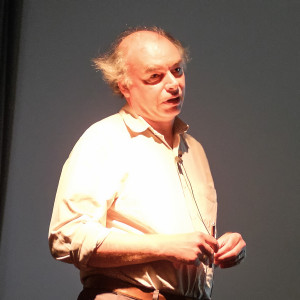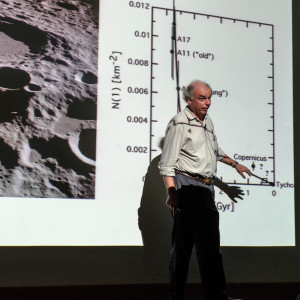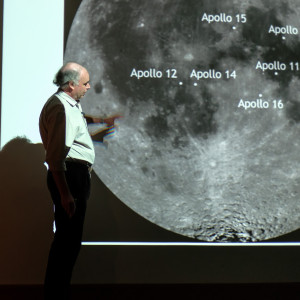May 19, 2014
The Scientific Legacy of Apollo and the Case for Renewed Exploration of the Moon
Professor Ian Crawford
Report by: Chris Sutcliffe
Professor Ian Crawford is Professor of Planetary Science and Astrobiology at Birkbeck College, University of London.
Apollo 17 was the last space mission to the moon in December 1972. One of the astronauts on this trip, Harrison Schmitt, was the first (and so far, only) scientist on the Moon; having gained his PhD is Geology from Harvard seven years earlier. 382 kilograms of rocks and soil samples from Apollo reside in the sample receiving curation facility at the Johnson Space Centre in Houston and 40 years later, scientists are still researching this material from Apollo.
Ian showed an illustration of the six Apollo landing sites on the Moon from 1969 to 1972. There were nine landing sites (six Apollo missions and three, robotic, Russian missions) from which samples have been returned. However, much of the Moon has not been fully explored; nothing on the western limb, nor on the far side, nor at high latitudes or at the poles. Whilst the samples which we have are extremely valuable, the spacecraft which have orbited the moon during the last 15-20 years tell us they are not fully representative of the geology of Moon, the Earth / Moon system and the history of the solar system. This is why, scientifically, it is important to go back to the Moon.
To go to the Moon takes a large mass that has to be accelerated to 11 km per second. There is a full-scale mock-up of Apollo 14 in the Science Museum. The last three Apollo missions became much more science orientated rather than having the objective of placing a man on the Moon. Astronauts on later missions were trained in field geology so that they could spot interesting features on the lunar surface.
In the last 15 years there has been a renaissance in studying the Moon using orbiting spacecraft. The last spacecraft that returned with samples was the Russian Lunar 24 mission in 1976. The US Lunar Reconnaissance Orbiter satellite, which has a very impressive suite of instruments, continues to be very successful.
Ian showed an image showing the tracks left by the rover from the Apollo spacecraft. These tracks will probably last for millions of years. The Apollo 17 astronauts covered 31km on the surface of the Moon, in three separate traverses, over a period of just three days. By contrast, it took the Opportunity vehicle on Mars nine years to traverse the same distance; this is part of the argument for human exploration.
Apollo 17 landed on a typical area of Mare basalt, where some of the rock samples are 3.75 billion years old, as old the oldest Earth rocks. A photograph taken of a nearby small 100 metre sized crater shows that, in this area, the surface colourisation is orange rather than a uniform grey. The orange soil is composed of orange and black glass beads, about 40 microns in diameter, which have been ejected in a volcanic eruption, proving that this area experienced volcanic activity 3.6 billion years ago.
Ian went on to his first argument on why renewed exploration of the Moon is necessary. This is to do with calibration of the inner solar system crater rate – a seemingly dull title, but something that is fundamental to determining the age of the surfaces of planets in the solar system. The way we date surfaces in the solar system is to count craters – older surfaces clearly have more craters. In order to know how old a surface is, we need a calibration between absolute age of the surface and number of craters. There is currently only one place where this relationship has been determined… the Moon.
Ian explained that there is a relationship between the number of craters and the age of the rock. The number of craters more than 1 km across per square km of lunar surface is plotted against the age of the surface in millions of years. This means that you can age the various parts of the Moon from which you do not have samples. However, we still have very little data. There are insufficient data points to give truly accurate ages, particularly with surfaces younger than 3 billion years old. Given that this data is used to date surfaces on Mars, Vesta, Mercury and eventually Pluto, the lunar data is key to understanding the age of these surfaces. To resolve this, we need to return to the Moon and sample some younger rocks.
The origin of the Moon has been ascertained from the analysis of the Apollo materials; lunar rocks are, mostly, very similar to terrestrial mantle rocks (except that they are depleted in volatile elements). The most effective theory behind this similarity is that the Moon was formed by a giant impact between a Mars-sized planetesimal and the early Earth. We would not have evidence for this theory if not for the Apollo samples.
Lunar regolith acts like a giant sponge, collecting everything that falls on it… solar winds, galactic cosmic rays, interplanetary dust particles… and it has been collecting this material for the duration of the solar system. It is therefore a record of the near Earth cosmic environment for the last 4 billion years, including the evolution of the Sun over this period. In order to take best advantage of this historical record, we need dedicated sampling missions to the Moon.
There is more to the Apollo legacy than rock samples; there is the geophysics and seismology. Seismometers were left on the Moon by all of the Apollo missions and most were active for eight years until 1978. They collected a huge amount of data in respect of the interior of the Moon, which is still being analysed today. In recent years, geophysicists have used much more advanced techniques, using software packages, to extract information out of very weak historic seismic data. Recently this data has been used to show that the Moon has a small two-layered core. This is data that we would not have if seismometers were not placed on the Moon 40 years ago. Black boxes were left near two Apollo landing sites, which were exploded after the astronauts left to provide seismic data for the near-surface structure of the Moon. There are many other places on the Moon that would benefit from this type of analysis, especially the far side.
Laser-reflectors are used to confirm the Earth-Moon distance, which confirms that the Moon is gradually receding from the Earth. Thermocouples were sunk into the surface of the Moon to determine the heat loss from the Moon’s core. None of this would have happened without Apollo. Apollo demonstrated the versatility of using human explorers, even though they are constrained by spacesuits.
Ian then highlighted the key advantages of human exploration, as follows:
- On the spot decision-making makes for flexibility and an increased chance of options and discoveries;
- Very efficient sample identification;
- Enhanced sample return capacity and capability;
- Facilitates deployment and / or maintenance of complex equipment.
The number of scientific papers resulting from Apollo has not plateaued, and indeed has accelerated since 2005.
So, why would we want to go back? Ian had three examples, though there are many more reasons.
- A better calibration of the lunar cratering rate, focusing on both younger and older surfaces; also on the far side of the Moon. This would allow us to more accurately determine the age of surfaces within the solar system.
- Nothing has been to the lunar poles. It is becoming clear that the poles of the Moon are special places, where there is a lot of shadow (the Sun is always on the horizon at the poles of the Moon). As the floors of craters at the poles are always in permanent shadow, they are very cold (as low as 25K). Water ices are stable in a vacuum at 25-40K, so potentially there is a record of water delivered from comets or meteorites from the early solar system.
- As the lunar regolith soaks up everything that falls on it, we have a potentially important astrophysical record on the Moon. The Sun has been around the galaxy 40 times since the Moon was formed… we may have passed through spiral arms, or there may be a record of nearby supernova. All of this will be preserved in the lunar regolith, providing vital information about the history of the Milky Way. The Apollo regolith samples were scooped up from the surface. We need to look at regolith in other places, such as under lava flows, as these will not have been exposed to the impact of meteorites, galactic storms, solar wind, cosmic rays etc.
A mission to Mars would also provide us with a rich source of information, but sending manned missions to Mars is very difficult. Moon missions would be far easier in comparison.
This was a brilliant lecture which reminded us of the immense value of the Apollo missions, and that so much was discovered that the samples returned to Earth are still being analysed, and will continue to be for many years to come. Ian made a very strong case for returning to the Moon, and won over many converts in the Flamsteed audience. Thank you to Ian for his superb talk and we wish him luck in convincing those who hold the purse strings to commit to future manned missions to the Moon.
Pictures from the Evening (by Mike Meynell):
Posted under: Flamsteed, Flamsteed Lecture, Meeting Report








You must be logged in to post a comment.